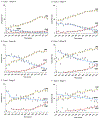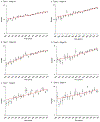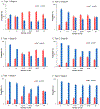Extent of pelvic lymphadenectomy and use of adjuvant vaginal brachytherapy for early-stage endometrial cancer
- PMID: 28017306
- PMCID: PMC7523385
- DOI: 10.1016/j.ygyno.2016.12.012
Extent of pelvic lymphadenectomy and use of adjuvant vaginal brachytherapy for early-stage endometrial cancer
Abstract
Objective: To examine trends of adjuvant radiotherapy choice and to examine associations between pelvic lymphadenectomy and radiotherapy choice for women with early-stage endometrial cancer.
Methods: The Surveillance, Epidemiology, and End Results Program was used to identify surgically treated stage I-II endometrial cancer between 1983 and 2012 (type 1 n=79,474, and type 2 n=25,020). Piecewise linear regression models were used to examine temporal trends of intracavitary brachytherapy (ICBT) and whole pelvic radiotherapy (WPRT) use, pelvic lymphadenectomy rate, and sampled node counts. Multivariable binary logistic regression models were used to identify independent predictors for ICBT use.
Results: There was a significant increase in ICBT use and decrease in WPRT use during the study period. ICBT use exceeded WPRT use in 2003 for type 1 stage IA, and in 2007 for type 1 stage IB and type 2 stage IA diseases. In addition, number of sampled pelvic nodes significantly increased over time in type 1-2 stage I-II diseases (mean, 7.0-12.7 in 1988 to 15.2-17.6 in 2012, all P<0.001). On multivariable analysis, extent of sampled pelvic nodes was significantly associated with ICBT use for type 1 cancer: adjusted-odds ratios for 1-10 and >10 nodes versus no lymphadenectomy in stage IA (1.38/2.40), IB (2.75/6.32), and II (1.36/2.91) diseases. Similar trends were observed for type 2 cancer: adjusted-odds ratios for stage IA (1.69/3.73), IB (2.25/5.65), and II (1.36/2.19) diseases.
Conclusion: Our results suggest that surgeons and radiation oncologists are evaluating the extent of pelvic lymphadenectomy when counseling women with early-stage endometrial cancer for adjuvant radiotherapy.
Keywords: Adjuvant radiotherapy; Early stage; Endometrial cancer; Intracavitary brachytherapy; Whole pelvic radiotherapy.
Copyright © 2016 Elsevier Inc. All rights reserved.
Conflict of interest statement
Disclosure statement
There is no conflict of interest in all authors.
Figures




Similar articles
-
Lymphadenectomy influences the utilization of adjuvant radiation treatment for endometrial cancer.Am J Obstet Gynecol. 2011 Dec;205(6):562.e1-9. doi: 10.1016/j.ajog.2011.09.001. Epub 2011 Sep 16. Am J Obstet Gynecol. 2011. PMID: 22030315
-
Stage IB endometrial cancer. Does lymphadenectomy replace adjuvant radiotherapy?Strahlenther Onkol. 2007 Nov;183(11):600-4. doi: 10.1007/s00066-007-1801-3. Strahlenther Onkol. 2007. PMID: 17960334 Review.
-
Trends in the utilization of adjuvant vaginal brachytherapy in women with early-stage endometrial carcinoma: Results of an updated period analysis of SEER data.Brachytherapy. 2016 Sep-Oct;15(5):554-61. doi: 10.1016/j.brachy.2016.06.012. Epub 2016 Jul 27. Brachytherapy. 2016. PMID: 27475480
-
Trends in the utilization of adjuvant vaginal cuff brachytherapy and/or external beam radiation treatment in stage I and II endometrial cancer: a surveillance, epidemiology, and end-results study.Int J Radiat Oncol Biol Phys. 2012 May 1;83(1):178-84. doi: 10.1016/j.ijrobp.2011.05.052. Epub 2011 Oct 17. Int J Radiat Oncol Biol Phys. 2012. PMID: 22014953 Free PMC article.
-
Vaginal brachytherapy alone is sufficient adjuvant treatment of surgical stage I endometrial cancer.Int J Radiat Oncol Biol Phys. 2005 Aug 1;62(5):1379-84. doi: 10.1016/j.ijrobp.2005.01.026. Int J Radiat Oncol Biol Phys. 2005. PMID: 16029796 Review.
Cited by
-
Systematic Lymphadenectomy and Oncological Outcomes of Women With Apparent Early-Stage Clear Cell Carcinoma of the Endometrium: A Multi-Institutional Cohort Study.Front Oncol. 2022 Mar 24;12:800957. doi: 10.3389/fonc.2022.800957. eCollection 2022. Front Oncol. 2022. PMID: 35402252 Free PMC article.
-
Trends of uterine carcinosarcoma in the United States.J Gynecol Oncol. 2018 Mar;29(2):e22. doi: 10.3802/jgo.2018.29.e22. Epub 2018 Jan 5. J Gynecol Oncol. 2018. PMID: 29400015 Free PMC article.
-
Decreasing Trends of Secondary Primary Colorectal Cancer among Women with Uterine Cancer: A Population-Based Analysis.J Clin Med. 2019 May 20;8(5):714. doi: 10.3390/jcm8050714. J Clin Med. 2019. PMID: 31137471 Free PMC article.
-
Lenvatinib plus pembrolizumab in patients with advanced or recurrent uterine carcinosarcoma.Gynecol Oncol Rep. 2021 Jul 24;37:100840. doi: 10.1016/j.gore.2021.100840. eCollection 2021 Aug. Gynecol Oncol Rep. 2021. PMID: 34401435 Free PMC article.
-
Patient compliance for postoperative radiotherapy and survival outcome of women with stage I endometrioid endometrial cancer.J Surg Oncol. 2017 Sep;116(4):482-491. doi: 10.1002/jso.24690. Epub 2017 May 25. J Surg Oncol. 2017. PMID: 28543055 Free PMC article.
References
-
- Siegel RL, Miller KD, Jemal A, Cancer statistics, 2016, CA Cancer J. Clin 66 (2016) 7–30. - PubMed
-
- Wright JD, Barrena Medel NI, Sehouli J, Fujiwara K, Herzog TJ, Contemporary management of endometrial cancer, Lancet 379 (2012) 1352–1360. - PubMed
-
- Keys HM, Roberts JA, Brunetto VL, Zaino RJ, Spirtos NM, Bloss JD, Pearlman A, Maiman MA, Bell JG, A phase III trial of surgery with or without adjunctive external pelvic radiation therapy in intermediate risk endometrial adenocarcinoma: a gynecologic oncology group study, Gynecol. Oncol 92 (2004) 744–751. - PubMed
-
- Creutzberg CL, van Putten WL, Koper PC, Lybeert ML, Jobsen JJ, Warlam-Rodenhuis CC, De Winter KA, Lutgens LC, van den Bergh AC, van de Steen-Banasik E, Beerman H, van Lent M, Surgery and postoperative radiotherapy versus surgery alone for patients with stage-1 endometrial carcinoma: multicentre randomised trial. PORTEC study group. Post operative radiation therapy in endometrial carcinoma, Lancet 355 (2000) 1404–1411. - PubMed
-
- Nout RA, Smit VT, Putter H, Jurgenliemk-Schulz IM, Jobsen JJ, Lutgens LC, van der Steen-Banasik EM, Mens JW, Slot A, Kroese MC, van Bunningen BN, Ansink AC, van Putten WL, Creutzberg CL, Vaginal brachytherapy versus pelvic external beam radiotherapy for patients with endometrial cancer of high-intermediate risk (PORTEC-2): an open-label, non-inferiority, randomised trial, Lancet 375 (2010)816–823. - PubMed
Publication types
MeSH terms
Grants and funding
LinkOut - more resources
Full Text Sources
Other Literature Sources

